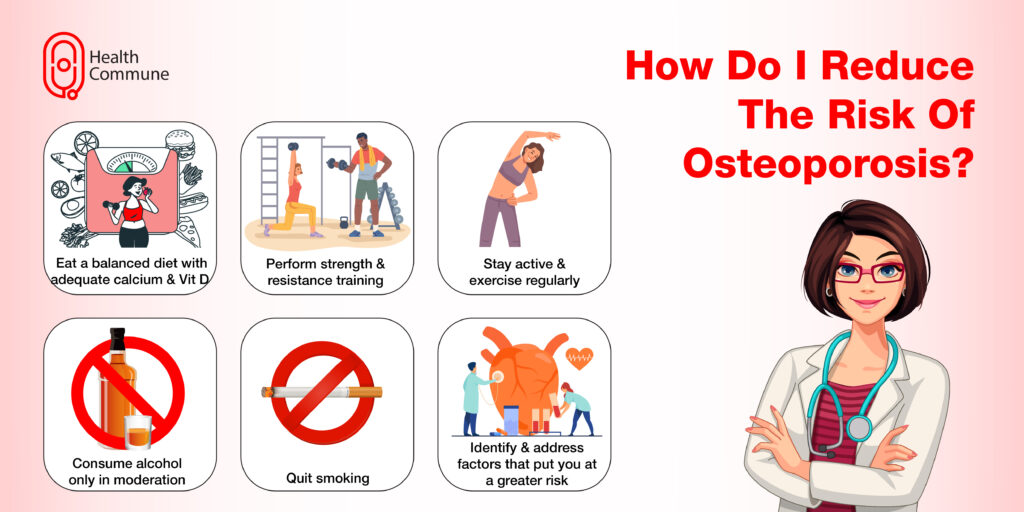Indians are increasingly suffering from osteoporosis. Read on to know more about its causes, risk factors, prevention, and management.
What is osteoporosis?
Osteoporosis (“porous bones”) is a condition that affects the bone, causing it to become weaker and brittle. It puts you at a greater risk for fractures, especially of the spine, hip, and wrist. It’s a common condition among Indians, with 46 million women over the age of 50 suffering from the disease.
What causes osteoporosis?
Why are Indians more prone to osteoporosis?
A combination of genetic and environmental factors can explain the increased incidence among Indians. These include:
- Diet with limited calcium and vitamin D intake
- Limited exposure to sunlight due to an increasingly indoor lifestyle
- Lack of exercise or physician activity
- Early menopause
- Poor awareness about bone health
What are the risk factors for osteoporosis?
You may be at a greater risk of developing this disease if:
- You’re a woman
- You’re above 50 years of age
- You’ve reached menopause
- You have someone in your family suffering from the disease
- You have a history of fractures in the past
- You have poor eating habits with a diet low in vitamin D and calcium
- You’re physically inactive
- You have a low body weight
- You consume large amounts of alcohol
- You’re a smoker
- You’ve been using corticosteroids for quite some time
- You’ve been on anti-epileptic drugs for a long time
- You’re suffering from medical conditions such as thyroid, parathyroid, or adrenal gland disorders, celiac disease, inflammatory bowel disease, cancer, etc.
What are the symptoms of osteoporosis?
While there are no specific symptoms in the early stages of the disease. Some common symptoms include:
- Lower back pain
- Bent or stooped posture
- Loss of height
- Difficulty in breathing (due to decreased lung capacity)
- Hip discomfort or reduced range of motion
- Fractures

When should I see a doctor?
You should consult your doctor if you have risk factors for osteoporosis or if you develop sudden, severe pain without any obvious or relatively mild injury.
How is osteoporosis diagnosed?
Your doctor will advise you to undergo the following tests:
- Bone Mineral Density (BMD) test or dual-energy X-ray absorptiometry (DEXA) scan to know the level of calcium and other minerals in your bones. It can diagnose as well as predict your risk of developing the disease. Based on your score, you can be categorised into
| DEXA scan score | Category |
|---|---|
| +1 to -1 | Normal |
| -1 to -2.5 | Osteopenia |
| -2.5 | Osteoporosis |
- Radiological assessment (X-rays or MRI scans) in case of any fractures
Is osteoporosis reversible?
How is osteoporosis treated?
Treatment involves a combination of supplements, exercise, lifestyle modifications, drug and hormone therapy.
- Calcium and vitamin D supplements
- Drug therapy
– Bisphosphonates: These prevent the breakdown of bone and help preserve their density
– Denosumab: It increases bone strength and density
– RANK ligand inhibitor: This prevents loss of bone density - Hormone therapy
– Estrogen, or a combination of estrogen and progestin: They can be used in post-menopausal women
– Estrogen agonist/antagonists: They can be used in post-menopausal women
What are the complications of osteoporosis?
Untreated or advanced-staged disease can lead to:
- Fractures: Spine fractures can lead to persistent and severe pain, stooped posture, and loss of height. A hip fracture is another serious condition that can cause extreme pain and severely limit your mobility. Fractures, in turn, can cause:
– Difficulty in performing your day-to-day activities
– Frequent hospital admissions, surgical interventions, and increased bed rest
– Depression
– Overall decreased quality of life
How can I reduce my chances of developing osteoporosis?
Simple lifestyle changes that can lower your risk include:
- Eating a balanced diet with adequate calcium and vitamin D
- Staying active and exercising regularly
- Doing strength and resistance training
- Consuming alcohol in moderation
- Quitting smoking
- Identifying any factors that put you at a greater risk
What foods are rich in calcium and vitamin D?
Top foods that are rich in calcium and vitamin D include:
- Dairy products like milk, cheese, curd, paneer, buttermilk, etc.
- Fatty fish like salmon, sardines, or tuna
- Eggs
- Spinach
- Oranges
- Soya or tofu
- Ladies finger, okra, or bhindi
- Sesame seeds
Additionally, just sitting under the sun daily for 10-20 minutes between 10 am to 3 pm can naturally increase your vitamin D levels.
How can I safeguard myself and my loved ones from falls and injuries?
To avoid falls and injuries:
- Ensure your house is well-lit
- Get regular eye checkups for good vision
- Use walking aids for proper balance
- Wear comfortable footwear
- Install handrails in the bathroom, toilet, and around the house




